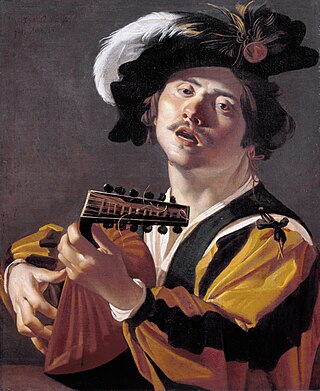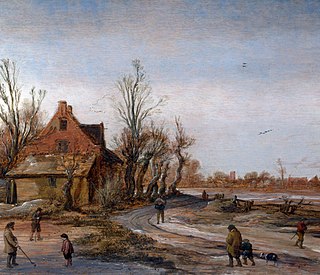
Dirck de Quade van Ravesteyn (1565 – 1620), was a Dutch Golden Age painter active in the court of Rudolf II, Holy Roman Emperor.

Dirck de Quade van Ravesteyn (1565 – 1620), was a Dutch Golden Age painter active in the court of Rudolf II, Holy Roman Emperor.
He was probably born in the Hague where his father Claes was a member of a family of artists. He is considered an important member of the internationally known Prague school of Dutch and Flemish painting under Emperor Rudolf II (who reigned from 1576 to his death in 1612). [1] Quade van Ravesteyn was successful enough to own his own house in the Malá Strana in 1598. [2] He was also recorded lending large sums of money in the same period, possibly to subcontract commissions or enable other artists to purchase properties. After Rudolf's death in 1612 he was succeeded by Matthias who died in 1619 and in that year Quade van Ravesteyn was mentioned as a creditor of both emperors, though he may have returned to the Netherlands by then. [2]
Like other Rudolfine artists, his works have been mostly dispersed over the world, with only a few remaining in Prague in the National Gallery there.

Rudolf II was Holy Roman Emperor (1576–1612), King of Hungary and Croatia, King of Bohemia (1575–1608/1611) and Archduke of Austria (1576–1608). He was a member of the House of Habsburg.

Matthias was Holy Roman Emperor from 1612 to 1619, Archduke of Austria from 1608 to 1619, King of Hungary and Croatia from 1608 to 1618 and King of Bohemia from 1611 to 1617. His personal motto was Concordia lumine maior.

Hans von Aachen was a German painter who was one of the leading representatives of Northern Mannerism.

Dirck Jaspersz. van Baburen was a Dutch painter and one of the Utrecht Caravaggisti.

Gerard van Honthorst was a Dutch Golden Age painter who became known for his depiction of artificially lit scenes, eventually receiving the nickname Gherardo delle Notti. Early in his career he visited Rome, where he had great success painting in a style influenced by Caravaggio. Following his return to the Netherlands he became a leading portrait painter. Van Honthorst's contemporaries included Utrecht painters Hendrick Ter Brugghen and Dirck van Baburen.

Adriaen de Vries (c.1556–1626) was a Northern Mannerist sculptor born in the Netherlands but working in Central Europe, whose international style crossed the threshold to the Baroque; he excelled in refined modelling and bronze casting and in the manipulation of patina and became the most famous European sculptor of his generation. He also excelled in draughtsmanship.

Esaias van de Velde was a Dutch landscape painter.

Roelant Savery was a Flanders-born Dutch Golden Age painter.

Bartholomeus Spranger or Bartholomaeus Spranger was a Flemish painter, draughtsman, sculptor, and designer of prints. Working in Prague as a court artist for the Holy Roman emperor Rudolf II, he responded to his patron's aesthetic preferences by developing a version of the artistic style referred to as Northern Mannerism. This style stressed sensuality, which was expressed in smoothly modeled, elongated figures arranged in elegant poses, often including a nude woman seen from behind. Spranger's unique style combining elements of Netherlandish painting and Italian influences, in particular the Roman Mannerists, had an important influence on other artists in Prague and elsewhere, in particular the Dutch Republic, as his paintings were disseminated widely through prints as well as by artists who had worked with him such as Karel van Mander.

Jacob Hoefnagel, was a Flemish painter, printmaker, miniaturist, draftsman, art dealer, diplomat, merchant and politician. He was the son of the Flemish painter and miniaturist Joris Hoefnagel (1542–1601) who was a court painter to the dukes of Bavaria and Emperor Rudolf II in Prague. Jacob Hoefnagel himself became a court painter to Rudolf II and to the Swedish court. He is noted for his illustrations of natural history subjects as well as his portraits, topographical views, emblems and mythological works, which continue his father's style.

Anselmus de Boodt or Anselmus Boetius de Boodt was a Flemish humanist naturalist, Rudolf II physician's gemologist. Along with the German known as Georgius Agricola with mineralogy, de Boodt was responsible for establishing modern gemology. De Boodt was an avid gems and minerals collector who travelled widely to various mining regions in Belgium, Germany, Bohemia and Silesia to collect samples. His definitive work on the subject was the Gemmarum et Lapidum Historia (1609).

Jan Anthonisz van Ravesteyn was a successful portrait painter to the Dutch court in The Hague.

Adriaen Hanneman was a Dutch Golden Age painter best known for his portraits of the exiled British royal court. His style was strongly influenced by his contemporary, Anthony van Dyck.

Northern Mannerism is the form of Mannerism found in the visual arts north of the Alps in the 16th and early 17th centuries. Styles largely derived from Italian Mannerism were found in the Netherlands and elsewhere from around the mid-century, especially Mannerist ornament in architecture; this article concentrates on those times and places where Northern Mannerism generated its most original and distinctive work.
Dirck van Delen or Dirck Christiaensz van Delen was a Dutch painter who specialized exclusively in architectural paintings, principally depicting palace perspectives and church interiors.

Bartholomeus Strobel the Younger or Bartholomäus in German or Bartlomiej in Polish was a Baroque painter from Silesia, who worked in Prague, Silesia, and finally Poland, where he emigrated to escape the disruption of the Thirty Years War.

Joos van Winghe, Jodocus a Winghe or Jodocus van Winghen (1544–1603) was a Flemish painter and print designer. He is known for his history paintings, portraits, allegories and genre scenes, including merry companies. He worked in Brussels as court painter and left Flanders after the Fall of Antwerp in 1584. He then worked in Frankfurt for the remainder of his career. In Germany he enjoyed the patronage of Holy Roman emperor Rudolf II and adopted a more clearly Mannerist style.

Paul Vredeman de Vries, was a Flemish painter and draughtsman who specialised in architectural paintings and, in particular, church interiors.
Paulus Aertsz van Ravesteyn was a Dutch printer who worked for local publishers, individuals and also published books himself. At his May 19, 1608, marriage to Elisabeth Sweerts in Amsterdam he is said to be a 21-year old typesetter from Dordrecht. Possibly he originated from North Brabant where his family owned land. His first own publication dates from 1611.

Pieter Stevens II or Peter Stevens II was a Flemish painter and draughtsman known for his landscapes. He left Flanders to work for the court of Emperor Rudolf II in Prague. The circulation of prints made after a series of romantic Bohemian landscape drawings by Stevens and other artists had an important influence on the development of Flemish and Dutch landscape art in the 17th century.